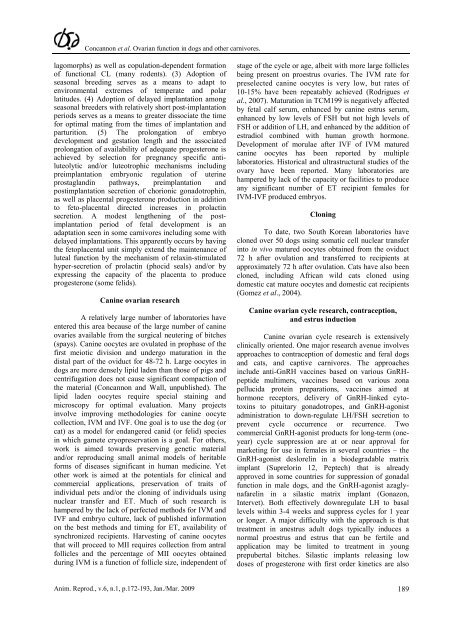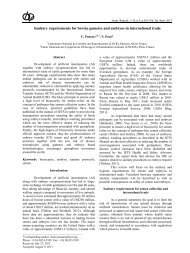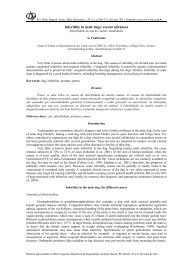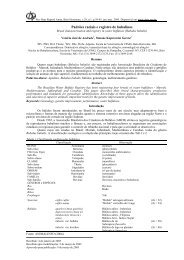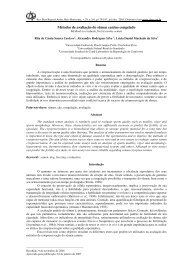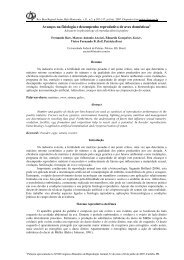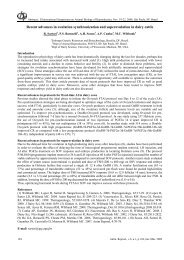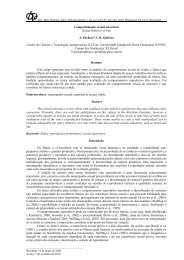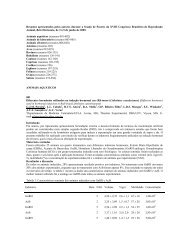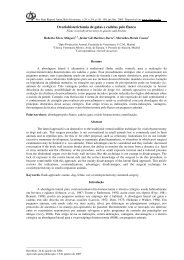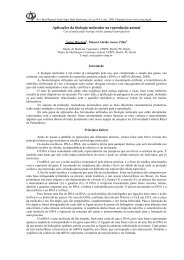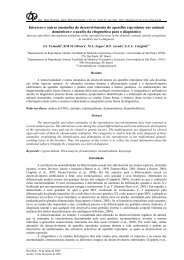Endocrine control of ovarian function in dogs and other carnivores
Endocrine control of ovarian function in dogs and other carnivores
Endocrine control of ovarian function in dogs and other carnivores
You also want an ePaper? Increase the reach of your titles
YUMPU automatically turns print PDFs into web optimized ePapers that Google loves.
Concannon et al. Ovarian <strong>function</strong> <strong>in</strong> <strong>dogs</strong> <strong>and</strong> <strong>other</strong> <strong>carnivores</strong>.<br />
lagomorphs) as well as copulation-dependent formation<br />
<strong>of</strong> <strong>function</strong>al CL (many rodents). (3) Adoption <strong>of</strong><br />
seasonal breed<strong>in</strong>g serves as a means to adapt to<br />
environmental extremes <strong>of</strong> temperate <strong>and</strong> polar<br />
latitudes. (4) Adoption <strong>of</strong> delayed implantation among<br />
seasonal breeders with relatively short post-implantation<br />
periods serves as a means to greater dissociate the time<br />
for optimal mat<strong>in</strong>g from the times <strong>of</strong> implantation <strong>and</strong><br />
parturition. (5) The prolongation <strong>of</strong> embryo<br />
development <strong>and</strong> gestation length <strong>and</strong> the associated<br />
prolongation <strong>of</strong> availability <strong>of</strong> adequate progesterone is<br />
achieved by selection for pregnancy specific antiluteolytic<br />
<strong>and</strong>/or luteotrophic mechanisms <strong>in</strong>clud<strong>in</strong>g<br />
preimplantation embryonic regulation <strong>of</strong> uter<strong>in</strong>e<br />
prostagl<strong>and</strong><strong>in</strong> pathways, preimplantation <strong>and</strong><br />
postimplantation secretion <strong>of</strong> chorionic gonadotroph<strong>in</strong>,<br />
as well as placental progesterone production <strong>in</strong> addition<br />
to feto-placental directed <strong>in</strong>creases <strong>in</strong> prolact<strong>in</strong><br />
secretion. A modest lengthen<strong>in</strong>g <strong>of</strong> the postimplantation<br />
period <strong>of</strong> fetal development is an<br />
adaptation seen <strong>in</strong> some <strong>carnivores</strong> <strong>in</strong>clud<strong>in</strong>g some with<br />
delayed implantations. This apparently occurs by hav<strong>in</strong>g<br />
the fetoplacental unit simply extend the ma<strong>in</strong>tenance <strong>of</strong><br />
luteal <strong>function</strong> by the mechanism <strong>of</strong> relax<strong>in</strong>-stimulated<br />
hyper-secretion <strong>of</strong> prolact<strong>in</strong> (phocid seals) <strong>and</strong>/or by<br />
express<strong>in</strong>g the capacity <strong>of</strong> the placenta to produce<br />
progesterone (some felids).<br />
Can<strong>in</strong>e <strong>ovarian</strong> research<br />
A relatively large number <strong>of</strong> laboratories have<br />
entered this area because <strong>of</strong> the large number <strong>of</strong> can<strong>in</strong>e<br />
ovaries available from the surgical neuter<strong>in</strong>g <strong>of</strong> bitches<br />
(spays). Can<strong>in</strong>e oocytes are ovulated <strong>in</strong> prophase <strong>of</strong> the<br />
first meiotic division <strong>and</strong> undergo maturation <strong>in</strong> the<br />
distal part <strong>of</strong> the oviduct for 48-72 h. Large oocytes <strong>in</strong><br />
<strong>dogs</strong> are more densely lipid laden than those <strong>of</strong> pigs <strong>and</strong><br />
centrifugation does not cause significant compaction <strong>of</strong><br />
the material (Concannon <strong>and</strong> Wall, unpublished). The<br />
lipid laden oocytes require special sta<strong>in</strong><strong>in</strong>g <strong>and</strong><br />
microscopy for optimal evaluation. Many projects<br />
<strong>in</strong>volve improv<strong>in</strong>g methodologies for can<strong>in</strong>e oocyte<br />
collection, IVM <strong>and</strong> IVF. One goal is to use the dog (or<br />
cat) as a model for endangered canid (or felid) species<br />
<strong>in</strong> which gamete cryopreservation is a goal. For <strong>other</strong>s,<br />
work is aimed towards preserv<strong>in</strong>g genetic material<br />
<strong>and</strong>/or reproduc<strong>in</strong>g small animal models <strong>of</strong> heritable<br />
forms <strong>of</strong> diseases significant <strong>in</strong> human medic<strong>in</strong>e. Yet<br />
<strong>other</strong> work is aimed at the potentials for cl<strong>in</strong>ical <strong>and</strong><br />
commercial applications, preservation <strong>of</strong> traits <strong>of</strong><br />
<strong>in</strong>dividual pets <strong>and</strong>/or the clon<strong>in</strong>g <strong>of</strong> <strong>in</strong>dividuals us<strong>in</strong>g<br />
nuclear transfer <strong>and</strong> ET. Much <strong>of</strong> such research is<br />
hampered by the lack <strong>of</strong> perfected methods for IVM <strong>and</strong><br />
IVF <strong>and</strong> embryo culture, lack <strong>of</strong> published <strong>in</strong>formation<br />
on the best methods <strong>and</strong> tim<strong>in</strong>g for ET, availability <strong>of</strong><br />
synchronized recipients. Harvest<strong>in</strong>g <strong>of</strong> can<strong>in</strong>e oocytes<br />
that will proceed to MII requires collection from antral<br />
follicles <strong>and</strong> the percentage <strong>of</strong> MII oocytes obta<strong>in</strong>ed<br />
dur<strong>in</strong>g IVM is a <strong>function</strong> <strong>of</strong> follicle size, <strong>in</strong>dependent <strong>of</strong><br />
stage <strong>of</strong> the cycle or age, albeit with more large follicles<br />
be<strong>in</strong>g present on proestrus ovaries. The IVM rate for<br />
preselected can<strong>in</strong>e oocytes is very low, but rates <strong>of</strong><br />
10-15% have been repeatably achieved (Rodrigues et<br />
al., 2007). Maturation <strong>in</strong> TCM199 is negatively affected<br />
by fetal calf serum, enhanced by can<strong>in</strong>e estrus serum,<br />
enhanced by low levels <strong>of</strong> FSH but not high levels <strong>of</strong><br />
FSH or addition <strong>of</strong> LH, <strong>and</strong> enhanced by the addition <strong>of</strong><br />
estradiol comb<strong>in</strong>ed with human growth hormone.<br />
Development <strong>of</strong> morulae after IVF <strong>of</strong> IVM matured<br />
can<strong>in</strong>e oocytes has been reported by multiple<br />
laboratories. Historical <strong>and</strong> ultrastructural studies <strong>of</strong> the<br />
ovary have been reported. Many laboratories are<br />
hampered by lack <strong>of</strong> the capacity or facilities to produce<br />
any significant number <strong>of</strong> ET recipient females for<br />
IVM-IVF produced embryos.<br />
Clon<strong>in</strong>g<br />
To date, two South Korean laboratories have<br />
cloned over 50 <strong>dogs</strong> us<strong>in</strong>g somatic cell nuclear transfer<br />
<strong>in</strong>to <strong>in</strong> vivo matured oocytes obta<strong>in</strong>ed from the oviduct<br />
72 h after ovulation <strong>and</strong> transferred to recipients at<br />
approximately 72 h after ovulation. Cats have also been<br />
cloned, <strong>in</strong>clud<strong>in</strong>g African wild cats cloned us<strong>in</strong>g<br />
domestic cat mature oocytes <strong>and</strong> domestic cat recipients<br />
(Gomez et al., 2004).<br />
Can<strong>in</strong>e <strong>ovarian</strong> cycle research, contraception,<br />
<strong>and</strong> estrus <strong>in</strong>duction<br />
Can<strong>in</strong>e <strong>ovarian</strong> cycle research is extensively<br />
cl<strong>in</strong>ically oriented. One major research avenue <strong>in</strong>volves<br />
approaches to contraception <strong>of</strong> domestic <strong>and</strong> feral <strong>dogs</strong><br />
<strong>and</strong> cats, <strong>and</strong> captive <strong>carnivores</strong>. The approaches<br />
<strong>in</strong>clude anti-GnRH vacc<strong>in</strong>es based on various GnRH-<br />
peptide multimers, vacc<strong>in</strong>es based on various zona<br />
pellucida prote<strong>in</strong> preparations, vacc<strong>in</strong>es aimed at<br />
hormone receptors, delivery <strong>of</strong> GnRH-l<strong>in</strong>ked cytotox<strong>in</strong>s<br />
to pituitary gonadotropes, <strong>and</strong> GnRH-agonist<br />
adm<strong>in</strong>istration to down-regulate LH/FSH secretion to<br />
prevent cycle occurrence or recurrence. Two<br />
commercial GnRH-agonist products for long-term (oneyear)<br />
cycle suppression are at or near approval for<br />
market<strong>in</strong>g for use <strong>in</strong> females <strong>in</strong> several countries – the<br />
GnRH-agonist deslorel<strong>in</strong> <strong>in</strong> a biodegradable matrix<br />
implant (Suprelor<strong>in</strong> 12, Peptech) that is already<br />
approved <strong>in</strong> some countries for suppression <strong>of</strong> gonadal<br />
<strong>function</strong> <strong>in</strong> male <strong>dogs</strong>, <strong>and</strong> the GnRH-agonist azaglynafarel<strong>in</strong><br />
<strong>in</strong> a silastic matrix implant (Gonazon,<br />
Intervet). Both effectively downregulate LH to basal<br />
levels with<strong>in</strong> 3-4 weeks <strong>and</strong> suppress cycles for 1 year<br />
or longer. A major difficulty with the approach is that<br />
treatment <strong>in</strong> anestrus adult <strong>dogs</strong> typically <strong>in</strong>duces a<br />
normal proestrus <strong>and</strong> estrus that can be fertile <strong>and</strong><br />
application may be limited to treatment <strong>in</strong> young<br />
prepubertal bitches. Silastic implants releas<strong>in</strong>g low<br />
doses <strong>of</strong> progesterone with first order k<strong>in</strong>etics are also<br />
Anim. Reprod., v.6, n.1, p.172-193, Jan./Mar. 2009 189


